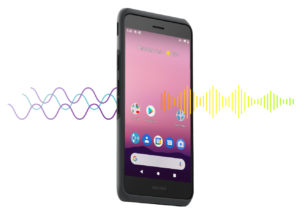Rethinking consumer smartphones for the enterprise

Five reasons why smartphones might not always be a smart choice
The Challenge of Consumer-Grade Smartphones in Vertical Industries
 The BYOD movement has captured the attention of most organizations with the promise of deploying familiar consumer smartphones to achieve higher productivity and lower costs. But deploying the wrong device can have just the opposite effect – loss of productivity and higher costs. Are consumer-grade smartphones the right choice for all employees? It’s a critical question that all organizations need to ask, and for certain types of employees, consumer devices are not the right choice.
The BYOD movement has captured the attention of most organizations with the promise of deploying familiar consumer smartphones to achieve higher productivity and lower costs. But deploying the wrong device can have just the opposite effect – loss of productivity and higher costs. Are consumer-grade smartphones the right choice for all employees? It’s a critical question that all organizations need to ask, and for certain types of employees, consumer devices are not the right choice.
In certain industries, there are large numbers of employees where consumer smartphones don’t make sense for the job. These users are identified by the following characteristics:
- Work in a building or campus all day and are highly mobile. They typically do not have a desk or any type of wired communication device such as a desk phone
- Use a mobile communication device that is critical to the employee’s job function. A failure, even temporarily, of the mobile communication device has an immediate and significant impact on productivity
- Do not need mobile communications while away from work, and the organization cannot justify the expense of a monthly cellular bill. Connectivity for the mobile device is via the in-building wireless network, Wi-Fi, or DECT
- Often share devices in a shift worker work environment, where a single mobile device is used among multiple employees. Devices are often used 24×7
- Sometimes work in harsh environments such as wet and dusty conditions, unforgiving cement floors, or must clean their phones using strong chemicals and cleaners
 Often called “deskless workers”, examples include a nurse roaming a hospital unit, a retail associate working the sales floor, or a manufacturing engineer out on a production line. These users need a mobile communication device that can handle the rigors of their various environments — purpose-built business tools designed specifically to help increase productivity. Consumer-grade smartphones are not designed for these users.
Often called “deskless workers”, examples include a nurse roaming a hospital unit, a retail associate working the sales floor, or a manufacturing engineer out on a production line. These users need a mobile communication device that can handle the rigors of their various environments — purpose-built business tools designed specifically to help increase productivity. Consumer-grade smartphones are not designed for these users.
Purpose-built, in-building mobile devices are specifically designed to meet the unique needs of mobile knowledge workers. Enterprise features include excellent voice quality over in-building Wi-Fi and DECT wireless networks, extensive battery life with long talk time and/or easily replaceable batteries, and ruggedized design. These purpose-built devices also have long product life cycles for years of service life and better TCO, security, manageability, and integration with key workplace applications.
Here are five key areas that every organization needs to carefully assess when considering whether to adopt consumer-grade smartphones in the workplace:
Reason 1 – Privacy and Security
 Unsurprisingly, security is the top concern for the burgeoning smartphone movement. 56% of companies in the US have dealt with a data breach, and 40% of organizations believe mobile devices are the company’s biggest security risk.
Unsurprisingly, security is the top concern for the burgeoning smartphone movement. 56% of companies in the US have dealt with a data breach, and 40% of organizations believe mobile devices are the company’s biggest security risk.
Mobile devices are designed to access and share data in the cloud, increasing the potential for data to be easily duplicated and moved between applications. This makes tasks such as accessing patient data while protecting the confidentiality of protected health information as required by the Health Portability and Accountability Act (HIPAA) a huge challenge. Retailers must maintain Payment Card Industry (PCI) data security standards compliance if using personal smartphones. These kinds of breaches can make corporate systems more vulnerable to malware and data theft.
Another big concern of IT professionals in BYOD environments is lost devices. If an employee’s device is stolen or goes missing, the best-case scenario is that it is an inconvenience. But in the worst-case scenario, you’re dealing with a complete disaster. If the employee wasn’t following corporate security protocols when using their device, loss or theft could cause a major breach. As consumer devices don’t come with an MDM, you cannot remotely wipe the device, so hackers don’t have the opportunity to access sensitive data.
With an enterprise wireless handset, many smartphone security challenges are simply avoided. For example, within a hospital environment, an enterprise wireless handset provides private and reliable wireless communication between caregivers and supporting staff while satisfying HIPAA concerns. Confidential data can be accessed via the handsets within the building but not when the device leaves the wireless network, and, there is no data stored on the device itself.
Reason 2 – Integration and Management
For companies willing to let employees select and purchase their own smartphones, the business must handle the diversity of multiple products and platforms. While employees find increased satisfaction, the use of multiple smartphone platforms makes the job more complicated, if not impossible, for IT or Telecomm teams. With new consumer handsets entering the market constantly, and firmware updates and fixes being released every few weeks, IT support will be stretched to meet demand.
Establishing and enforcing corporate policy on company-issued devices is seen as key to compliance. However, it’s hard to enforce these policies on workers using personal devices. Should an employee leave the company, the device leaves too, and the organization might be unable to reclaim sensitive data.
Compliance with industry and Federal regulations also creates an added burden on ongoing support. For most organizations, being able to identify employees and control regulated content as well as archiving important electronic communications all adds to the overhead associated with smartphones.
In-building wireless handsets are easy for IT teams to manage because they:
- Don’t leave the building
- Don’t store data that could get into the wrong hands
- Are designed to be robust so less likely to suffer physical problems
- Are less likely to be lost or stolen as they do not work outside the workplace
Reason 3 – Call and Phone Quality
 Making and receiving voice calls is still the primary use for in-building mobile communications devices. Interrupted or dropped phone calls can create frustration for employees and customers or patients. It is critical to maintain the equivalent voice quality, reliability, and functionality
Making and receiving voice calls is still the primary use for in-building mobile communications devices. Interrupted or dropped phone calls can create frustration for employees and customers or patients. It is critical to maintain the equivalent voice quality, reliability, and functionality
expected from a wired telephone.
One of the greatest challenges for smartphones in in-building work environments is delivering acceptable voice quality when using an organization’s in-building Wi-Fi network. Smartphones are primarily designed for cellular voice calls and data. Most smartphones do support Wi-Fi functionality, but this support is optimized for data, not voice, and are typically missing key features such as Quality of Service (QoS) support for prioritizing voice packets. Voice has a very low tolerance for network errors and delays. Gaps of only a few hundred milliseconds will deteriorate voice quality.
Purpose-built Wi-Fi or DECT handsets are designed to deliver a continuous, reliable connection as a user moves throughout the building or campus. Users move from hallway to patient room to meeting room, roaming from one Wi-Fi or DECT access point to another during the transition, with no loss of packets or degradation of audio quality.
Reason 4 – User Productivity
The personal use of mobile devices while at work can create disruptive situations. Nurses, retail store associates, and manufacturing workers are more likely to get distracted if using personal smartphones at work, taking their attention away from the task at hand or reducing their overall productivity. Text messages, social media, and personal calls cannot be ‘turned off’ or separated. Sensitive data is another issue with smartphones. In Healthcare, for example, smartphone features could potentially allow the violation of patient privacy by sharing photographs or texts.
In addition, by providing smartphones to roaming mobile employees, companies enable the ability for ancillary productivity killers like surfing the web. According to a survey by International Data Corp (IDC) on employee productivity:
- 30-40% of employee internet activity is non-work related
- Internet usage at work is costing US businesses $63 billion in lost productivity each year
- The average employee admits to spending 1-3 business hours per day for recreational internet use
Reason 5 – Total Cost of Ownership
When exploring the cost of implementing smartphones in an organization, management should look at several ‘hidden’ areas of cost. These can include lack of durability, the potential for theft, support requirements, and accessories required to make a consumer-grade phone suitable for business use. Organizations need to look at the total cost of owning a smartphone over its lifetime of usage, not just the initial cost of procurement.
Some organizations report up to 60% replacement of smartphones per year due to damage or other failures. Organizations need to carefully assess the conditions where a broken device can jeopardize a project, a sale, or even a life.
Protective cases or sleds can provide additional durability protection for consumer-grade devices, but at a cost. Chargers and extra batteries add even more cost – although some smartphone devices are sealed units that do not enable battery replacements. To maintain employee productivity, provisions must be made to ensure that employees are always able to get a replacement device for any devices that are out of use. This generally means stocking extra phones to replace those out of service due to battery recharging or those that have failed due to damage from dropping, shock, dust, or moisture. Since smartphones are small and easily removed from the work premises, they can also be a prime target for theft.
Consumer smartphones usually have short lifecycles, often measured in months, before a new, ‘improved’ version is available. Frequently these changes are minor features that have no bearing on improving employee productivity. Replacing like-for-like phones can be impossible if older versions have been discontinued. Newer versions of devices may have different form factors or use different accessories, requiring additional unplanned investments.
Many smartphones have created their own ecosystem of aftermarket add-ons that can make a phone highly customizable to particular uses and environments. These can add key functionality such as industrial barcode readers or magnetic card readers. But many of these add-ons can be made obsolete by a simple change of physical dimension or a phone’s connector port.
Conclusion
As smartphones continue to extend their march into the workplace, it is becoming increasingly clear that they are not always the right choice for the specialized needs of in-building mobile employees working in vertical industries such as healthcare, retail, and manufacturing.
In the case of companies that have a large percentage of in-house mobile employees and use in-building wireless, the benefits of purpose-built devices easily outweigh the fragile nature of smartphones, their weak call quality with in-building wireless networks, high TCO, and poor battery performance, all of which impact worker productivity.
